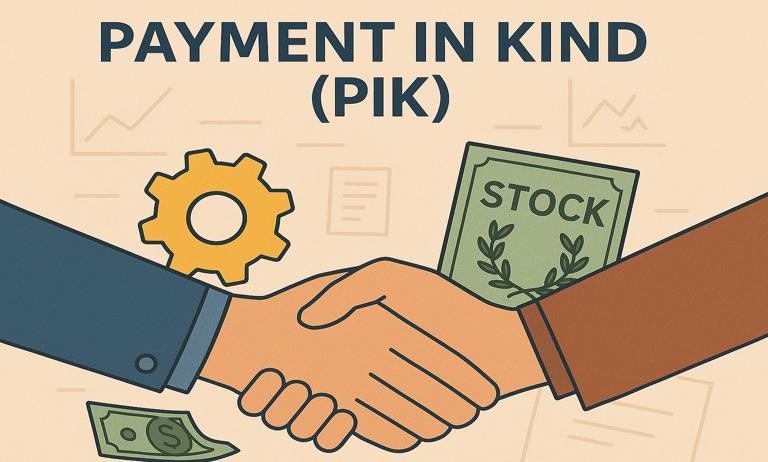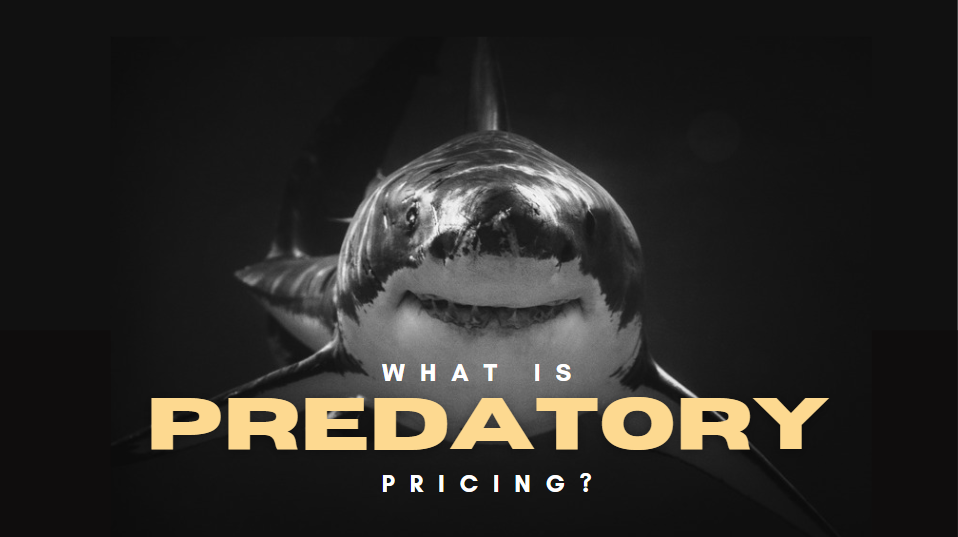PIK (Payment in Kind)
Suppose a
startup takes out a loan but has limited cash, which it wants to conserve for
smooth operations. Instead of making cash payments, it may agree to compensate
the lender by offering a slice of its equity or by having the interest added to
the principal balance. That's the concept of Payment-in-Kind (PIK) financing,
where obligations are settled not in cash, but through alternative forms such
as equity or additional debt. Upon loan maturity or refinancing, the borrower
repays the original principal along with the accumulated PIK interest.
But not all
PIK arrangements are created equal. Depending on the nature of the agreement
and the goals of the parties involved, PIK can take different forms — each with
its own structure, purpose, and implications.
To better
understand how PIK functions in modern finance and business, let’s explore the
three main types of Payment in Kind:
1.
Equity-Based PIK
Equity-based
PIK enables companies, especially startups and fast-growing firms, to conserve
cash by issuing shares or ownership stakes instead of cash payments to fulfill
obligations. This strategy aligns the interests of employees and creditors with
the company's future performance, serves as an incentive by offering potential
long-term growth benefits, though it comes with the potential risk of equity
depreciating if the company does not perform well. It is widely used to attract
and retain talent, manage cash flow effectively, and foster a sense of shared
success among stakeholders. However, its effectiveness depends heavily on the
company’s financial health and market prospects.
2.
Debt-Based PIK
Debt-based
PIK, or PIK interest, allows companies to defer interest payments by adding
them to the loan’s principal balance instead of paying in cash. For instance, a
$10 million loan with 5% interest turns into $10.5 million after incorporating
the interest. This approach is often used by businesses with tight cash flow or
in leveraged buyouts (LBOs), where private equity firms need breathing room to
stabilize operations or generate returns before repaying debts. Debt-based PIK
provides short-term cash relief but can significantly increase liabilities over
time, posing risks if the borrower fails to generate sufficient income to cover
the growing debt. It is an approach that offers short-term adaptability while
posing potential financial hurdles in the long run.
3. Hybrid
PIK
Hybrid PIK
merges equity-based and debt-based models, allowing companies to fulfil
obligations using a mix of additional debt and equity, tailored to negotiated
terms. This approach helps balance short-term liquidity with long-term value
creation, offering flexibility to both parties. Lenders may receive capitalized
interest that can later convert into equity, enabling potential future gains.
Common in complex financial deals, hybrid PIKs require careful valuation and
negotiation to address the risks and challenges of dual compensation
structures.
Why Companies Turn to PIK: Strategic
Insights
Companies
opt for PIK for several strategic reasons, like-
· Cash Flow Relief: Companies facing cash flow issues
can use PIK arrangements to defer cash payments. It allows them to reserve
their cash for working activities or reinvestment.
· Attractive to Creditors/Employees: It offers a way for companies to
compensate or reward creditors or employees without immediate cash payouts,
while also potentially giving them more value in the future if the company
grows.
· Debt Restructuring: Debt-based PIK is commonly used as
part of restructuring efforts to avoid default while giving the company
breathing room.
Understanding
why PIK is used provides a foundation to evaluate its impact. By examining its
positive aspects and potential drawbacks, we can develop a clearer picture of
its suitability for various scenarios.
Positive
Aspects of Payment in Kind:
1.
Improved cash flow for companies: PIK supports businesses in conserving cash by providing
non-cash payment methods like stocks, bonds, or services. This can be
particularly advantageous for companies in their growth phase or during times
of financial constraints, as it enables them to redirect available cash towards
critical business activities or expansion efforts.
2.
Optimize operational efficiency to mitigate financial risk: By leveraging PIK arrangements,
companies can focus on improving their core operations without the constant
pressure of liquidating assets or sourcing cash. This approach not only
supports long-term stability but also helps mitigate risks associated with
sudden cash shortages, which could otherwise disrupt business continuity.
3.
Prospect of enhanced investor returns: PIK often provides investors with higher returns as
compensation for the delayed cash payment. For example, a PIK bond might offer
a higher yield compared to regular bonds, incentivizing investors by rewarding
their patience with potentially greater financial benefits.
4.
Offers access to exclusive investment opportunities to investors: PIK arrangements often come with
unique opportunities, such as equity stakes or convertible securities, which
can lead to significant upside potential. These opportunities are appealing to
investors seeking alternatives to traditional fixed-income investments and are
willing to take on higher risks for potentially greater rewards.
Demerits
of Payment in Kind:
1.
A key risk factor is the increasing burden of debt obligations: PIK often defers immediate payment
but results in the accumulation of debt obligations over time. For instance, in
the case of PIK loans or bonds, the interest is rolled into the principal
amount, leading to compounding debt. This can create financial strain,
particularly for companies that struggle to meet future repayment obligations.
2.
A paramount concern for investors is the increased likelihood of default
events: The deferred payment structure of PIK
heightens default risks, as companies may struggle to generate sufficient cash
flow to manage their growing financial obligations. For investors, this
heightened risk requires careful evaluation of the issuing company's financial
health and repayment capabilities.
3.
The valuation of non-cash returns presents an additional challenge: Unlike cash payments, non-cash
returns (e.g., stocks or other securities) can be difficult to accurately value
due to market volatility and changing conditions. This creates uncertainty for
investors and may complicate decision-making processes, as the future value of
their returns is less predictable.
4.
Tax Implications: While Payment in Kind arrangements offer flexibility and strategic
advantages, they also come with important tax considerations that both
companies and recipients must navigate carefully. Unlike traditional cash
transactions, PIK involves non-cash compensation, which can complicate how
income, expenses, and liabilities are reported for tax purposes.
Rise
of PIK Over Recent Years and What It Means for the Private Credit Market
The increased use of payment-in-kind (PIK) loans in recent
years, especially during the COVID-19 pandemic, was driven by critical
liquidity needs, the growth of the private credit market, and strong demand
from investors. With traditional cash flows shrinking, companies turned to PIK
loans to defer interest payments and protect their capital reserves. Meanwhile,
private lenders used PIK structures to offer more flexible financing options,
and investors, seeking higher returns in a low-interest-rate environment, were
willing to take on the associated risks in exchange for potential higher
yields.
As reported by S&P Global in the article titled "BDC
Assets Show the Prevalence of Payments-in-Kind Within Private Credit,"
published on December 12, 2024(1), “The amount of loans making PIK
payments within BDCs' portfolios has risen to $39.1 billion in loans (at fair
value) in the second quarter of 2024, up from just under $25 billion in the
second quarter of 2023. Together, these loans represented about 11.7% of the
total fair value of the loans held by BDCs in the second quarter, up slightly
from 11.5% in the first quarter.”
Also, as per the same article by S&P Global, “Just 10% of the loans (by
fair value) currently making PIK payments are scheduled to mature through 2025,
and more than two-thirds of these loans won't mature until at least 2028”.
Over the recent years, PIK loans have become increasingly
common within private credit portfolios, reflecting a broader shift in borrower
and lender preferences. In a high-interest-rate environment, borrowers are
opting to conserve cash by deferring interest payments, while lenders are
accepting non-cash income in exchange for the potential of longer-term returns.
A notable portion of these loans appears to originate from newer financing
deals that incorporate flexible repayment terms, such as revenue-based lending
structures, that allow interest to be paid in kind until a predefined
conversion or refinancing milestone is reached. This trend signals a continued
reliance on creative structuring as borrowers navigate limited refinancing
options.
The Evolving Role of PIK Within the BDC Landscape
PIK loans have become a versatile financing solution in the
post-pandemic landscape, providing temporary relief to companies grappling with
liquidity constraints. However, their sustainability depends on careful
management, as they pose considerable risks, including the potential for debt
accumulation, a higher likelihood of default, and increased exposure for
investors.
According to Fitch Ratings article “BDC Cash Income
Dividend Coverage Pressured by Payment-in-Kind Income”, dated September 03,
2024(2), “In 2Q24, 18 Fitch-rated BDCs exhibited cash earnings
dividend coverage (NII adjusted for net non-cash interest income/regular
declared dividends) below 100% despite strong growth in NII from high rates.
Sustained cash earnings coverage below 100% is viewed negatively. For 2Q24, PIK
averaged 9.0% of interest and dividend income for the rated peer group, up from
8.7% in 1Q24 and 8.4% in 2Q23.” Also, “In 2Q24, cash earnings dividend coverage
fell to 95.4%, on average. We see continued pressure on coverage from rising
PIK income, spread compression, higher non-accruals, and additional rate cuts
in 2H24.”
BDCs, which are required to distribute 90% of their taxable
income to shareholders, are seeing growing pressure on their ability to cover
dividends with actual cash earnings. This strain is being intensified by rising
levels of non-cash income from Payment-in-Kind (PIK) interest, which does not
generate immediate cash inflows. As PIK income expands, the gap between
reported income and cash available for payouts widens. Looking ahead, factors
like potential interest rate cuts, tighter lending margins, and rising credit
stress could further weigh on net earnings and dividend coverage.
Concerns Around PIK Loans
PIK loans, traditionally associated with distressed
borrowers or junior debt, are now increasingly present across the broader
credit landscape. This shift reflects growing borrower demand for cash-flow flexibility
but also introduces new risks, since deferring interest payments can sometimes
hide deeper financial strain that isn't immediately visible to lenders or
investors.
As noted in the Bloomberg article “Growing Risks from
Payment-in-Kind Debt Draw Watchdog Scrutiny” (Jan 12, 2025) (3),
“The International Monetary Fund is planning a deep dive on the growing
prevalence of payment-in-kind debt that allows companies to defer interest
payments, amid wider fears the tool could undermine financial stability by
obscuring stress.” This growing reliance on PIK structures is prompting
regulators to more closely examine the connections between private credit
markets and the traditional banking system, particularly as transparency
remains limited in this rapidly expanding sector.
Conclusion:
Payment-in-Kind (PIK) financing has grown beyond
its traditional role in distressed situations and is now a widely used strategy
across various sectors of the financial market. By allowing companies to
conserve cash through non-cash payments, such as issuing equity or rolling
interest into principal, PIK offers short-term flexibility that can be
especially valuable during periods of financial stress or economic uncertainty.
However, this flexibility comes with important
trade-offs. The growing reliance on PIK can lead to higher debt burdens,
reduced transparency, and increased risk of default, particularly if companies
struggle to generate future cash flows. As the use of PIK becomes more common, especially
within private credit and BDC portfolios, regulators and investors alike are
paying closer attention to its potential impact on financial stability.
Ultimately, while PIK can be a useful financial
tool when applied thoughtfully, it requires careful management, clear
communication, and a strong understanding of the risks involved. Its rise
highlights the need for greater transparency in private credit markets and a
balanced approach to risk and reward.
Sources:
1.
S&P Global, BDC Assets Show The Prevalence
Of Payments-In-Kind Within Private Credit, December 12, 2024 (Link)
2.
Fitch Ratings, BDC Cash Income Dividend Coverage
Pressured by Payment-in-Kind Income, September 03, 2024 (Estimates of the
amount and share of loans making PIK payments are based on available
disclosures from more than 165 BDCs, including both rated and unrated BDCs and
interval funds.) (Link)
3.
Bloomberg, “Growing Risks From Payment-in-Kind
Debt Draw Watchdog Scrutiny”, January 12, 2025 (Link)
4.
Accounting Insights, “ Understanding Payment in
Kind (PIK): Types, Taxes, and Risks”, July 8, 2024 (Link)



